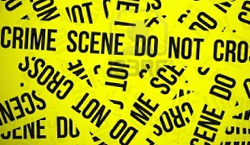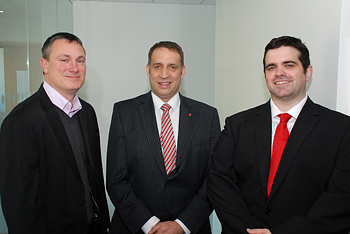Time of death is the key for cold cases
Mon, 16 Dec 2013 15:27:00 GMT
Advances in Temporal Forensics Investigations conference attracts leading forensic scientists and CSIs
 SOME of the world’s leading forensic scientists and crime scene investigators attended a conference at the University of Huddersfield, which probed the crucial time dimensions of criminal investigations. They include time-since-death, time-since-deposition of stains, age-estimation of individuals and sequencing of events of interest.
SOME of the world’s leading forensic scientists and crime scene investigators attended a conference at the University of Huddersfield, which probed the crucial time dimensions of criminal investigations. They include time-since-death, time-since-deposition of stains, age-estimation of individuals and sequencing of events of interest.
In addition to a succession of scientific papers dealing with the latest research in the field, the event was also groundbreaking because it brought together specialists in different disciplines of forensics and criminology that do not normally collaborate closely.
Opening speaker Det Supt Mark Ridley (centre) of West Yorkshire Police with conference co-organisers Dr Jason Roach (left) and Dr Graham Williams (right).
 That could begin to change, however, and the University of Huddersfield’s Dr Graham Williams – who chaired the organising committee – believes that the conference might have laid the groundwork for much greater levels of co-operation and increasingly successful investigations as a result.
That could begin to change, however, and the University of Huddersfield’s Dr Graham Williams – who chaired the organising committee – believes that the conference might have laid the groundwork for much greater levels of co-operation and increasingly successful investigations as a result.
The conference took place at the University’s 3M Buckley Innovation Centre and was entitled Advances in Temporal Forensics Investigations.
“The time aspect is now one of the burning issues in forensics,” explained Dr Williams. “In the past it’s been about who did it, why they did it and how did it – the next question is when they did it.”
The opening address at the conference was from Det Supt Mark Ridley, of the West Yorkshire Police Homicide and Major Enquiry Team. Then followed two days of keynote addresses and presentations from academic researchers and police officers – such as West Yorkshire Police’s Det Insp Howard Atkin (pictured below right), who discussed how forensic temporal analysis could aid the investigation of cold cases.

 Eminent overseas contributors included Dr Maurice Aalders (left), of the Academic Medical Centre in The Netherlands, who spoke on the use of forensic biophysics to determine the age of bruises and bloodstains. Professor Céline Weyermann (pictured below right), of the University of Lausanne, gave a keynote address on “situating forensic traces in time”. Dr Pasquale Poppa (pictured below left), of the University of Milan, spoke about forensic anthropology in Europe.
Eminent overseas contributors included Dr Maurice Aalders (left), of the Academic Medical Centre in The Netherlands, who spoke on the use of forensic biophysics to determine the age of bruises and bloodstains. Professor Céline Weyermann (pictured below right), of the University of Lausanne, gave a keynote address on “situating forensic traces in time”. Dr Pasquale Poppa (pictured below left), of the University of Milan, spoke about forensic anthropology in Europe.

 There were several contributions from University of Huddersfield researchers. The criminologist Dr Jason Roach spoke about advances in forensic temporal analysis and how they affected the criminal investigator. Dr Zhijie Xu, of Huddersfield’s School of Computing and Engineering, teamed up with Professor Ying Liu of ShaanXi Forensic Science and Court Technology Centre in China to describe advanced methods of analysing digital forensic evidence. Dr Stefano Vanin, of the University’s Forensic Biology Group, spoke about a project to establish and validate a method of estimating the amount of time a cadaver had been submerged in sea water. His PhD student Esta Bostock presented a paper on chronobiology and forensic entomology.
There were several contributions from University of Huddersfield researchers. The criminologist Dr Jason Roach spoke about advances in forensic temporal analysis and how they affected the criminal investigator. Dr Zhijie Xu, of Huddersfield’s School of Computing and Engineering, teamed up with Professor Ying Liu of ShaanXi Forensic Science and Court Technology Centre in China to describe advanced methods of analysing digital forensic evidence. Dr Stefano Vanin, of the University’s Forensic Biology Group, spoke about a project to establish and validate a method of estimating the amount of time a cadaver had been submerged in sea water. His PhD student Esta Bostock presented a paper on chronobiology and forensic entomology.
Other contributors to the conference included key figures from the forensic science industry, such as Dr Philip Avenell of Forensic Access Ltd and Derek McKenzie of Kite Innovations.
Dr Graham Williams said that the basis of the conference, which made it highly innovative, was its inter-disciplinary nature. It had experts from fields that included chemistry, biology, criminology and investigative psychology plus experienced police detectives.
“As far as I am aware this is the first time that they have all come together in this way and it was enormously beneficial. A lot of the delegates were fascinated and surprised by the work being done by colleagues in different disciplines,” said Dr Williams, who is himself carrying out cutting-edge research in the use of microRNA analysis for detecting the origin of body fluids and estimating the time since-deposition of body fluid stains, which could be a major investigative aid.
The Advances in Temporal Forensics Investigations conference was organised by a committee drawn from the University of Huddersfield’s Schools of Applied Sciences, Computing and Engineering and Human and Health Sciences. It is hoped that the success of the event will lead to major new research collaborations and funding bids.







